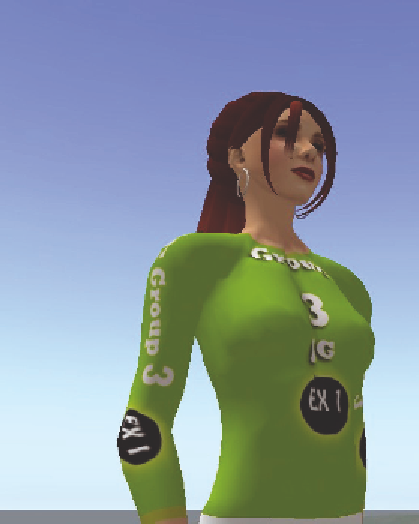Graphics Programs Reference
In-Depth Information
privacy and collaboration. Rooms also
included boxes containing avatar clothing
for the group. The entire second floor was
dedicated to the Fish Bowl scenario, where
students and teacher debated and groups
presented their collaborative work on a
wide presentation board. Decoration in the
educational places was kept at a minimum,
reducing the students' unnecessary cogni-
tive load.
•
Moderator Hats:
Five coloured hats were
designed; one for each Jigsaw group, in
order to be worn by the avatar of the user
assigned the role of moderator in the group
collaboration activities and discussions.
Animations and gestures
Non-verbal communication seems to be highly
beneficial to user interactions in CVEs. The term
“Non-verbal communication” is commonly used
to describe all human communication events
which transcend the spoken or written word
(Knapp, 1978).
Second Life already offers a set of basic ges-
tures for world residents. Collaborative scenario
interaction analysis revealed some basic gestures,
animations or poses needed to support users in
collaborative activities; gestures that were not
built-in in SL were designed with Poser 6.0. Table
5 below shows the built-in avatar metaphors in SL.
Avatar Attire
The implementations that concern the avatars'
appearance are mainly related to the clothes that
they wear during the online meetings. Many of
the eligible requirements about an avatar's ap-
pearance (e.g., show the avatar's name) don't
need to be implemented because they are already
covered by SL's built-in functions. Our research
team implemented the following objects, regard-
ing avatar attire:
•
Jigsaw Shirts:
Five coloured shirts were
designed, one for each Jigsaw group.
Group members were differentiated based
on shirt colour. Shirts had indicators for
Group name and number. Our aim was to
design shirts that become obvious from far
and from as many viewpoints as possible.
Therefore, we placed group indicators on
four different points of the shirt: front,
back, left and right arm.
Figure 2. Example of implemented avatar attire
•
Expert Group Jackets:
Were implement-
ed as “transparent” Jackets containing only
the expert group indicator label, intended
to be worn over the Jigsaw Shirt. Expert
group indicator labels were placed again on
three different points of the jacket: front,
back, left and right arm. For example, the
avatar's clothes in Figure 2 reveal that this
user belongs to Jigsaw Group 3 and Expert
Group 1.

Search WWH ::

Custom Search